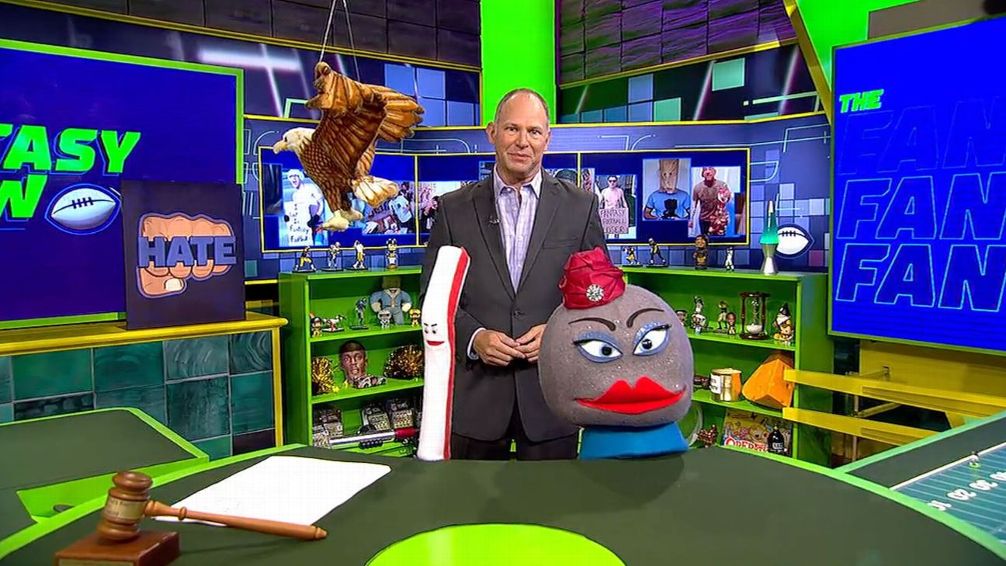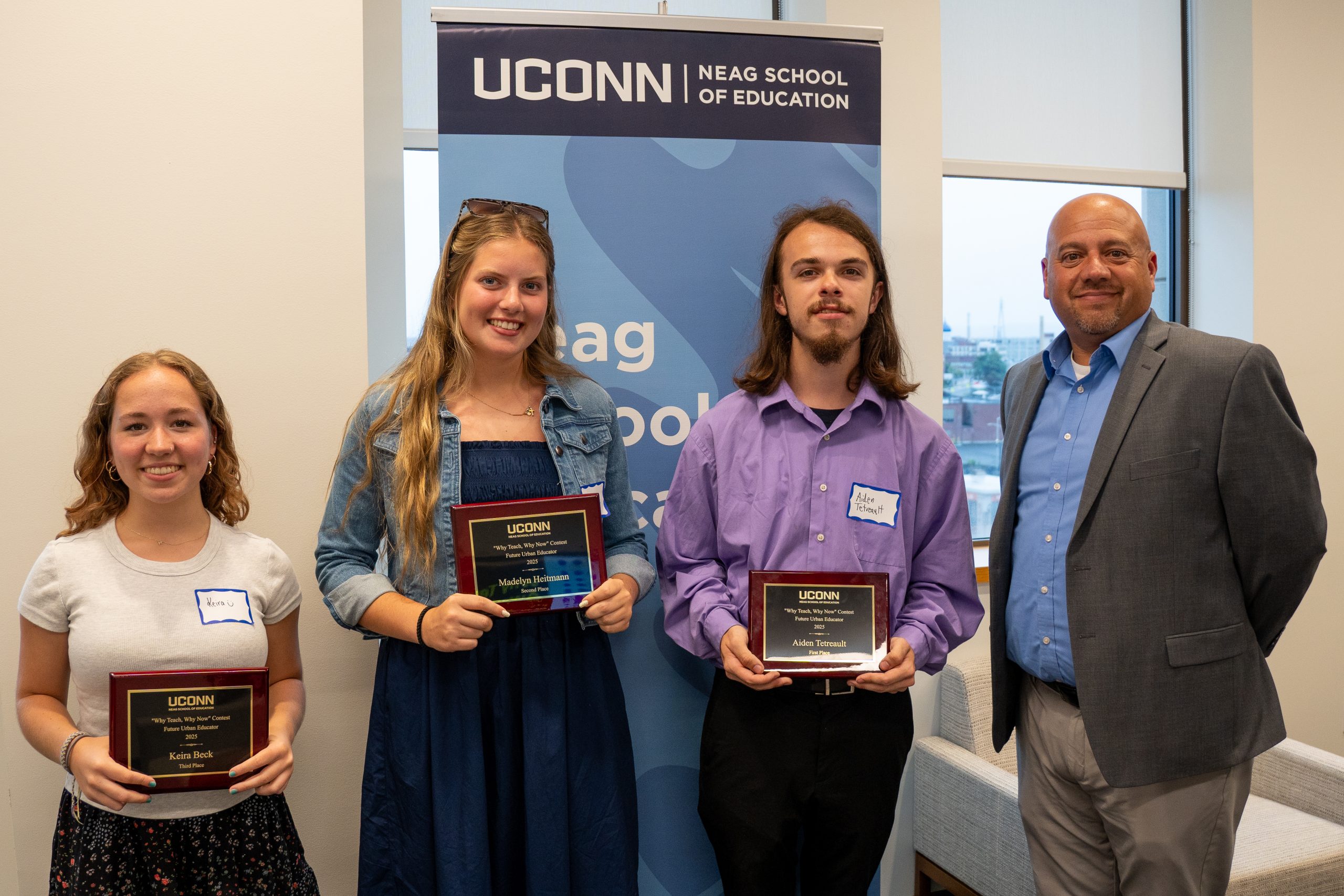If you sit down at 5pm and turn on ESPN 2, instead of sports you may be bewildered by eagles falling from the sky, talking fish, sassy puppets, and much more. The Fantasy Show with Matthew Berry is a show dedicated to Fantasy Football, and we had the honor of sitting down with the creative individuals working behind-the-scenes who made the ideas come to life: Paul Spirito, UConn Puppet Arts Technical Supervisor and Edward Weingart, UConn Assistant Professor of Technical Direction.
> Watch a Video Tour of The Fantasy Show with Matthew Berry Set!
What was the inspiration for The Fantasy Show with Matthew Berry?
Paul: Fantasy football is a huge, multi-billion dollar business and I think ESPN wanted to capitalize on it. Matthew Berry, the host of the show, is an international fantasy football expert. Everyone that wants to play fantasy football looks to him for guidance. He is the guru! He works for ESPN and has a quirky personality, which is perfect for what ESPN wanted to embody with this project.
Edward: It’s essentially Pee-Wee Herman’s Playhouse meets Mad Money. The executives didn’t want a show that looked like anything else on ESPN. Basically, Paul did all the Pee-Wee Herman side of things and I did all the Mad Money side as far as our involvement in the project.
How did you initially become involved in the show?
Paul: ESPN often calls us when they need a puppeteer to be in a mascot. The last time was March Madness I believe. ESPN reached out to a UConn alum for a puppeteer contact, and I was connected through him. Most of ESPN shows are an anchor sitting at a desk with pictures over his shoulder. That’s their standard, they could do that in their sleep. This show embodies everything they’re not used to doing, so they called in our help.
Edward: ESPN hired a company I consult for, Creative Conners, which is an entertainment industry automation company. I am the Director of Special Projects and also the only employee that lives in Connecticut, the company is based in Warren, Rhode Island. Most of Creative Conners clients purchase stock machinery which move things across stages, elevators, and hoists. I typically get involved when a client is looking for an effect that falls outside our stock products. Usually I just design though, and this is the first time I was involved in the installation process.
Were you both interested in Fantasy Football before?
Paul: I’ve always been a football fan, but I had never played Fantasy Football before. It was interesting to hang out with Matthew Berry because it’s amazing how attuned and educated he is in this field. In a meeting, you could see him turn it on and he becomes the ESPN expert with stats and information flying out. I had to learn how Fantasy Football worked so I could make educated suggestions. I did a crash course essentially to get up to speed and make valuable suggestions in meetings.
Edward: While I am a football fan I’ve never done any fantasy football. The League, an FX TV show about a group of guys who played Fantasy Football, taught me everything I know about it. Matthew Berry was on it actually. That was the only way I had a clue of what they were talking about.
Did the crew give you specifics about what they wanted you to design or were you given a lot of creative freedom?
Paul: Ed Eck, the producer, and I created the puppets together. We exchanged pictures, we created drawings and came up with a design we wanted and went for it. They encouraged me to help them come up with ideas and then execute them in the puppetry world.
Edward: As a Technical Director my job isn’t ever to create the idea. Instead we are enablers who find creative technical designs solutions that will make the ideas happen. Their initial request was to make the show similar to Mad Money, and from there they shared some of the individual effects they were thinking about. For example, they wanted to be able to control the Billy Bass plaque mounted talking fish on the wall. We bought one, took it apart, and rebuilt it so we could control and program the three motors to move it’s mouth accordingly to the sound on the show. After all of the effects were designed and built I spent about three weeks in the studio installing and integrating everything, so it all worked together.
What was the experience like working in the ESPN studio?
Paul: I actually didn’t work in the studio a lot, I would meet with them in a conference room, bounce around ideas, show them puppets and options, and then work on them remotely. I worked in the studio once everything was done. One interesting thing is that Ed and I both worked on this project beginning to end and neither of us knew the other one was involved!
Edward: When I found out there were puppets on the show, I knew there was a high probability someone from UConn did it because our program is so huge here. I was fairly certain it was somebody I knew and found out it was Paul. For my work in the studio, all the things I did were physically integrated into the set, whereas the puppets can be carried around. It was difficult because there was another show that shoots in that studio so we had to work around all of their schedules.
Paul: I was there once early in the morning to test a puppet while another show was being filmed in the same studio. We were climbing underneath the anchor’s table and dodging cameras.
What is the filming process of the show?
Paul: It’s such a fast turnaround. They shoot from 10am-2pm and then the show goes on at 5pm. So from 5pm onwards they are creating the show for the next day, which they have to have ready to shoot at 10am again. I don’t know how they do it! A daily half hour show is a challenge. It’s funny, if a player even sneezes it’ll get on the show because their business is knowing the inside scoop on every player so the public can make decisions accordingly. It’s intense, there’s very little time to create the show before it’s on. How do they do all that writing on a topic that just happened that day?
Do you think someone who doesn’t watch fantasy football would enjoy the show?
Paul: Someone who never turns on ESPN could turn on this show and at least be interested because it’s not the same as anything else. It’s very casual and informal, which is an opening to a viewer who isn’t necessarily into sports.
Edward: But the segments of information are long in between the interesting things.
Ed, the set looks so playful! There are so many creative effects. What is your favorite that you installed? Which was the most difficult?
Edward: The one I enjoy the most when it happens is the Eagle, especially when it brings in the tweets. The one that was the most interesting and challenging to create is the trap door. It was really tricky to get it to work at the speed they wanted. It’s a favorite because it was a challenge.
Paul, which puppet was your favorite character?
Paul: If I had to pick a favorite it would be the crystall ball, which they haven’t used yet but they’re getting ready to. We discussed how we wanted a crystal ball with an attitude inspired by Wanda Sykes, the comedian. I went away and designed her with this inspiration in mind. When we presented her to them, we worked on a skit so the first time the producers saw her she was in character. It’s not a dead puppet in a box but it’s alive as it comes out of the box. It makes a connection in your brain that this puppet is a character, not just an inanimate object.
Are there any puppets that took on a character you were surprised by?
Paul: For Straw Man, they wanted to illustrate a straw man argument, an old saying for an empty argument. They made a strong character choice, so they know the role of that character in other relationships on the show and find ways to use him relatively easily. The puppeteer that performs Straw Man is a natural puppeteer even though he has no training. This character that he used for Straw Man is a character that he embodies a lot in normal day-to-day conversation. Everyone has a silly voice they use when they’re trying to be funny and this is this guy’s. The Brooklyn accent and the feistiness are all adding up to be one successful puppet character. And that was one of the things Matthew Berry said originally: ‘All the puppets on the show should be jerks. They all hate me and I’m frustrated by them.’ That’s the overall theme for all the puppet characters, they are all disgruntled and none of them want to be there. The first line we talked about the robot saying was “I can do three billion computations a minute, but I’m here working on this stupid fantasy football show. Why am I not being used to solve world peace?” All the puppets have attitude on the show.
Do you design the puppets according to their personality as well?
Paul: Crystal Ball is a perfect example of that; however, Straw Man was made as cute as possible so when he has that attitude it’s amplified. The audience is surprised that this adorable little puppet is a real jerk!
Do you feel that puppetry is making a comeback?
Paul: During the 2000’s, CGI was being used for everything. Recently with the resurgence of Star Wars and Broadway shows, puppets have made a real comeback. People relate to puppets.
Edward: It’s also easier to make performance adjustments because you have a person performing rather than a computer programmer.
Paul: You can change lines on the fly and adjust performances, whereas in computer graphics it is what it is. You’d have to spend more time making a small change.
Will you both be continuing to do work on the show?
Paul: There are puppets that I’ve designed and built that they haven’t used yet. I think they’re trying to introduce things little by little. They’re not trying to throw everything into the first episode because then they won’t have anything else. While I was there, the producer and I threw around a couple ideas for new characters I might be building soon. Hopefully, if the show is successful it’ll keep growing.
Edward: I’ll continue working with them by doing maintenance. I’m going to do the first inspection of all the mechanics this Tuesday to ensure everything is working right. And of course I’m there to reprogram in case they want to change things. It’s very interesting because it works differently than any other automation job I’ve ever done. Typically, you have an automation operator who’s sitting at a computer with our software and hit a button that elicits an effect – something flies in, a door opens, whatever the programmed effect is. On this show, there are two button panels and each button is mapped to do a different thing. More interestingly, the buttons can be changed to trigger different effects. Integrating it all together is something I’ve never done before at that level. If it ends up being picked up for a second season, it will more than likely get moved to a larger studio and get rebuilt. It’s funny, in theater we work on small budgets a lot of times on shows. This was a tiny budget show for ESPN but it was more than all of Connecticut Repertory Theatre’s entire annual production budget. They cut a lot of corners and had to make a lot of compromises in what they wanted to do creatively, so I’m hopeful they do well for another season with a more flexible budget.



